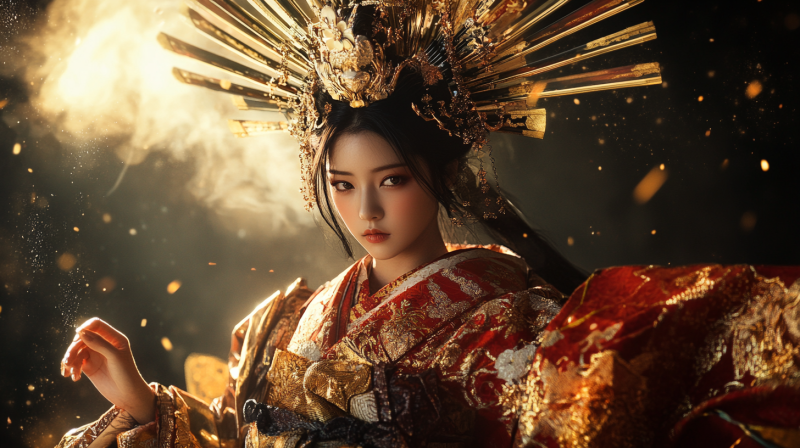The Amazons immediately conjure up images of fierce warrior women who are fearless in combat and unwavering in their devotion to a life of the sword. These legendary figures have been etched into the annals of Greek mythology as a race of powerful women who defied the norms of their time, living in a matriarchal society where men played a subordinate role. Yet, the Amazons remain a tantalizing mystery, straddling the line between myth and reality; their stories have been told and retold through the ages, capturing the imagination of countless generations.
In this exploration of the Amazons, we will delve into their origins, the rich myths surrounding them, and the possibility that these legendary warriors may have been more than just myth. We will journey through ancient texts, archaeological findings, and modern interpretations to paint a vivid picture of who the Amazons were, what they represented, and why their legacy endures.
The Origins of the Amazons
The origins of the Amazons are shrouded in myth, with their earliest mentions appearing in Greek literature dating back to the 8th century BCE. The poet Homer is among the first to reference these warrior women in his epic poems. In “The Iliad,” the Amazons are described as “antianeirai,” a term often translated as “those who fight like men.” This phrase encapsulates the essence of the Amazons, women who were the equals of men in strength, courage, and martial prowess.
According to Greek mythology, the Amazons were the daughters of Ares, the god of war, and the nymph Harmonia. This divine parentage endowed them with extraordinary martial skills and an unquenchable thirst for battle. They were said to live in a distant land, often placed on the fringes of the known world, such as the Caucasus Mountains, Scythia, or Asia Minor. Their capital was believed to be Themiscyra, a city on the banks of the Thermodon River, where they ruled over a society that was entirely female-dominated.
The Amazons were known for their strict customs and rigorous training, which began in childhood. Girls were taught to ride horses, wield weapons, and hunt, all with the goal of becoming formidable warriors. The most famous symbol of their commitment to warfare was the alleged practice of removing one breast to better wield a bow, although this particular detail is more likely a later embellishment than a historical fact.
Amazonian Society: A World of Warrior Women
The Amazons’ society was one that defied the conventions of the ancient world. In Greek culture, women were largely confined to domestic roles, their lives centered around the home and family. The Amazons, in stark contrast, lived in a matriarchal society where women held all the power and men were relegated to subservient roles.
In Amazonian society, men were primarily used for procreation, and once their role was fulfilled, they were either sent away or kept as servants. Male children, in some versions of the myth, were either killed, sent back to their fathers, or left to fend for themselves. This extreme separation of the sexes underscores the Amazons’ commitment to maintaining their female-dominated social structure.
The Amazons’ martial lifestyle was not just a matter of survival but a core aspect of their identity. They were depicted as living for the thrill of battle, often engaging in wars with neighboring tribes and even the Greek heroes themselves. The Amazons were also known for their unique form of governance, where the queen, often a figure of immense power and respect, led them. These queens, such as Hippolyta, Penthesilea, and Antiope, became legendary in their own right, their deeds immortalized in the myths and stories that have survived to this day.
The Myths of the Amazons: Heroes, Battles, and Tragedies
The Amazons occupy a significant place in Greek mythology; their stories intertwined with those of the most famous heroes of the ancient world. These myths often portray the Amazons as both formidable adversaries and potential allies, depending on the context of the tale.
One of the most famous myths involving the Amazons is the story of Heracles and his ninth labor, where he was tasked with retrieving the girdle of Hippolyta, the Amazon queen. The girdle, a symbol of her authority, was a gift from Ares, and obtaining it was no small feat. In the myth, Heracles initially succeeded in persuading Hippolyta to give him the girdle willingly. However, Hera, the queen of the gods and Heracles’ implacable foe, stirred up trouble by spreading rumors among the Amazons that Heracles intended to abduct their queen. This led to a fierce battle in which Hippolyta was killed, and Heracles ultimately took the girdle by force.
Another prominent myth involving the Amazons is the tale of Theseus and Antiope. According to the myth, Theseus, the king of Athens, either kidnapped or seduced Antiope, an Amazonian queen or princess, depending on the version of the story. This act led to the Amazons launching an attack on Athens, a rare instance of the Amazons venturing into the heart of Greece. The ensuing battle, known as the Attic War, was a defining moment in Athenian myth, symbolizing the clash between the patriarchal society of Greece and the matriarchal world of the Amazons. Despite their valor, the Amazons were ultimately defeated, and Antiope, who had fallen in love with Theseus, was killed during the conflict.
The Amazons also played a crucial role in the Trojan War, one of the most famous conflicts in Greek mythology. Penthesilea, the queen of the Amazons, led her warriors to Troy to aid King Priam after the death of Hector, one of the city’s greatest defenders. Penthesilea was driven by a desire for glory and redemption as she sought to atone for accidentally killing her sister. In the heat of battle, Penthesilea encountered Achilles, the mightiest of the Greek heroes. Their duel was one of the most dramatic moments of the war, with Achilles ultimately killing Penthesilea. However, as he removed her helmet and saw her face, Achilles was struck by her beauty and regretted slaying her—a poignant moment that highlights the tragic nature of many Amazonian myths.
The Historical Basis of the Amazons: Myth or Reality?
For centuries, the Amazons were regarded as purely mythological figures, the product of Greek imagination and storytelling. However, in recent decades, historians and archaeologists have begun to explore the possibility that the Amazons may have had a basis in reality.
One of the most compelling pieces of evidence for the existence of the Amazons comes from the study of the Scythians, a nomadic people who lived on the vast steppes of Central Asia, north of the Black Sea. The Scythians were known for their warrior culture, and archaeological findings have revealed that women in Scythian society often participated in battle alongside men. Burials of Scythian women have been found with weapons, armor, and other artifacts typically associated with warriors, suggesting that these women were not only combatants but also held positions of authority and respect within their society.
Some academics believe that encounters with Scythian women served as inspiration for the Greek myths because the Scythians’ practice of having women warriors is strikingly similar to the tales of the Amazons. The Greeks, upon encountering these fierce female warriors, may have woven tales that exaggerated and mythologized their abilities, eventually creating the legends of the Amazons.
Additionally, ancient authors such as Herodotus, often referred to as the “Father of History,” wrote about the Sauromatae, a tribe he claimed was descended from the Amazons and Scythians. Herodotus’ accounts describe a society where women fought alongside men and where young girls were not allowed to marry until they had killed an enemy in battle. While Herodotus’ writings are often a blend of history and myth, they provide intriguing clues that the Amazons may have been based on real warrior women.
Another possible historical basis for the Amazons is found in the warrior queens of Anatolia and other regions of Asia Minor. The Hittites, for example, had several powerful queens who led armies and ruled in their own right. These queens, along with the matriarchal societies of the region, may have contributed to the Greek concept of the Amazons as a race of female warriors.
The Symbolism of the Amazons: Femininity, Power, and Fear
The Amazons have long been a symbol of the complex relationship between femininity, power, and fear in the ancient world. To the Greeks, the Amazons represented the antithesis of their own societal norms. In a culture where women were expected to be submissive and focused on domestic duties, the Amazons were a shocking inversion of these roles, embodying the idea of women who were independent, powerful, and even threatening.
The Amazon myths can be seen as a reflection of Greek anxieties about gender roles and the potential for women to challenge male authority. The Amazons’ martial prowess and refusal to adhere to traditional gender roles made them both fascinating and frightening to the Greeks. Their tragic endings, in which male heroes defeated or subdued the Amazons, served to reinforce the notion that male dominance was necessary for the natural order of society.
At the same time, the Amazons also represented an ideal of female strength and autonomy. For women in the ancient world, the Amazons were a symbol of what was possible beyond the constraints of patriarchal society. They were admired for their courage, their skill in battle, and their unwavering commitment to their way of life. Even as the myths often portrayed them as ultimately defeated, the Amazons’ legacy as powerful and independent women has endured.
In modern times, the Amazons has been reinterpreted through various lenses. Feminist readings of Amazonian myths highlight the ways in which these stories challenge traditional gender roles and offer a vision of a society where women hold the reins of power. Popular culture, from comic books to films, has continued to explore and reimagine the Amazons, often portraying them as symbols of female empowerment and strength.
The Legacy of the Amazons: Mythology and Popular Culture
The legacy of the Amazons extends far beyond the pages of ancient texts. Their stories have inspired countless works of literature, art, and popular culture. From the heroic tales of the ancient Greeks to the modern reinterpretations of their mythos, the Amazons have left an indelible mark on the cultural imagination.
In literature, the Amazons have appeared in various forms, from ancient epic poems to contemporary novels. Their stories have been retold and reimagined in countless ways, reflecting changing attitudes toward gender and power. In art, the Amazons have been depicted in everything from ancient pottery to Renaissance paintings, often serving as symbols of both female strength and the dangers of defying societal norms.
In popular culture, the Amazons have become iconic figures, appearing in comic books, films, and television series. Characters such as Wonder Woman, with her origins rooted in Amazonian mythology, have brought the legendary warriors into the modern era, transforming them into symbols of female empowerment and heroism. The Amazons’ influence can also be seen in the portrayal of strong, independent female characters in various media, reflecting the enduring appeal of their mythological legacy.
The Amazonian myths continue to captivate audiences and inspire new interpretations, ensuring that the legendary warrior women of ancient Greece remain a potent symbol of strength, courage, and defiance.
Conclusion
The Amazons of ancient Greece stand as one of the most intriguing and enduring myths of the ancient world. Their stories of fierce warrior women, their battles with legendary heroes, and their unique societal structures have fascinated and inspired people for centuries. Whether viewed as mythical creations or as reflections of real historical figures, the Amazons represent a powerful symbol of female strength and autonomy.
As we look back on the myths and legends of the Amazons, we are reminded of the ways in which stories can both reflect and shape our understanding of gender, power, and identity. The Amazons, with their rich tapestry of myths and their complex legacy, continue to capture the imagination and inspire us to explore the boundaries of possibility and the power of storytelling.
References
- Homer. “The Iliad.” Translated by Samuel Butler. Project Gutenberg, 2008.
- Herodotus. “Histories.” Translated by George Rawlinson. Project Gutenberg, 2009.
- Graves, Robert. “The Greek Myths.” Penguin Books, 1955.
- Hamilton, Edith. “Mythology: Timeless Tales of Gods and Heroes.” Little, Brown and Company, 1942.
- Schliemann, Heinrich. “Tiryns: The Prehistoric Palace of the Kings of Tiryns.” William Heinemann, 1885.
- Bingham, Hiram. “Inca Land: Explorations in the Highlands of Peru.” Macmillan, 1922.
- Tokarev, Sergei. “The Scythians and the Amazons.” Soviet Ethnography, 1971.





